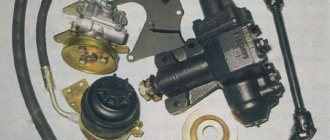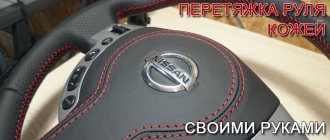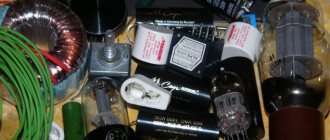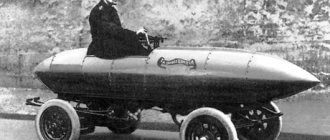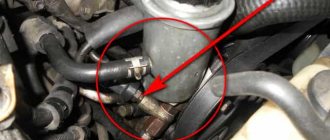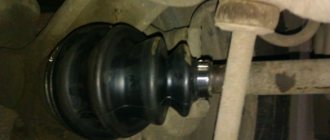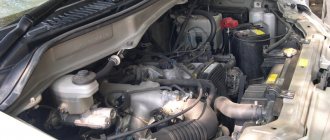What types of power steering are there?
- Power steering - power steering. This amplifier operates using oil pressure. The design and installation of such equipment is quite complex, and such an amplifier requires constant maintenance. If everything is done correctly, then the power steering will delight you with a smooth steering wheel motion.
- Electric power steering (electromechanical) copes well with the load, its installation is much easier and faster. On the VAZ 2107 it works as efficiently as oil power steering. Probably the most important thing is that it works on the “set it and forget it” principle. The electric amplifier operates from the on-board 12 V power supply system (maximum current 50A).
Let's consider the principle of operation and installation of a domestic electric power steering.
The electric power steering creates an additional moment of force with the electric motor, acting synchronously with the driver’s hands. The steering wheel gain is 5.7. This means that when turning the steering wheel, if the driver puts in 20 kg of his own force, then with the electric power steering he will need 3.5 kg.
What is included in the EUR kit?
- the amplifier itself;
- intermediate cardan;
- bracket for mounting on the steering column;
- additional parts - fasteners, wires and decorative casing.
How does electric power steering work?
The principle of its operation is complex, it uses feedback:
- The torque sensor detects the force applied to the steering wheel by the driver and its direction and converts the impulses into an electrical signal; In addition to the torque sensor, there are also sensors for vehicle speed, crankshaft speed, ignition key position, etc., each of them also generates a signal and sends it to the control unit.
- The control unit produces a summing signal, which is sent to the electric power steering motor.
- The electric motor does the “reverse work” by converting the electrical signal into steering movement.
The speed sensor leads to the fact that the faster the car moves, the less force, that is, the steering wheel becomes “heavier”. The electric motor turns on when needed, and you can hear it hum slightly.
3-5 seconds after turning on the ignition, the EUR starts working.
If any problems occur in the power circuit, the EUR will simply turn off, the warning light will come on, and the car will return to manual control.
Stages of work execution
Due to the lack of power steering on the car, many car owners decide to install power steering on the VAZ 2107 with their own hands. Auto mechanics believe that the EUR of a Priora or Niva often fails. In some cases, the steering wheel jams. Such problems are dangerous when the machine is moving. Therefore, it is recommended to give preference to factory electric amplifiers.
In any case, you will need to adjust the gearbox speed sensor. Otherwise, when starting the VAZ and driving at low speeds, the driver will not be able to notice any changes. Thus, it will be difficult to turn the steering wheel. When accelerating at high speed, the steering wheel will yield to the car owner with little resistance.
If there is no speed sensor, you will have to install one. It must have a 6-pulse pass-through from the Niva 214. As a rule, this is included in the factory equipment. Other design changes that will need to be made include:
- transfer of another choke cable, which is included in the kit for the VAZ 2108 electric booster,
- replacing the gearbox - you will need to take this unit with a short worm shaft, and the bipod must be original,
- If the 2107 has a contact ignition system, you will need to install the MUR1100E diode yourself.
The ESD kit for the “Seven” includes the following elements.
- Speed sensor.
- Fasteners.
- Choke cable.
- The ignition switch, steering column switches, steering column cover - these parts must be from 2110.
- Installation instructions and passport for electric power steering on a VAZ.
In order to make life easier for the driver, having the ability to rotate the steering wheel “with one finger”, confidently park the car without breaking his hands at low speeds and speeds, power steering has long existed throughout the civilized world, which can be installed on a VAZ without much pain “ classics."
Installing electric power steering on a VAZ: Video
On a VAZ 2110. With the help of this device, turning the car’s steering wheel becomes much easier. What does the power steering consist of? First of all, it is a pump that is driven by the crankshaft. The pump begins to pump oil or other liquid into other small parts of the mechanism. The EUR device is a little simpler; it consists of an electric motor, a torsion bar, several sensors and an ECU. The operating principle is as follows: the torsion bar begins to twist, the torque is read by the sensor, and the electric motor increases the action of the output shaft.
Let's start installing the device on the VAZ 2110. We install the electric amplifier on the shaft. During installation, it becomes clear that the steering shaft is a little small in size. We will have to drill a hole in the adjacent plate. Next we hook the central part of the switches. The next step is the power wiring. We stretch two wires from the passenger compartment to the car battery. We carry out the broaching through the left wing; for this we will have to open the fuse box. We remove the washer reservoir, take the wire and insert it into the wires. We attach the ends of two wires from the EUR to the other end of the wire and pull them into the engine compartment. We dismantle the instrument panel of the VAZ 2110, remove the red block, drag the wiring into the sub-panel plane and remove the orange wire from the red block. We attach the block that comes with the wires to it. We make connections to the electric amplifier wiring. Let's consider the advantages of the EUR. During operation, there is no need to interfere with its operation, that is, it does not require maintenance, unlike the power steering.
In power steering, the driver needs to constantly monitor the oil level and tubular connections. The electric power steering motor only functions when the steering wheel needs to be turned, that is, when the torsion bar begins to twist. When stationary, the motor practically does not work, nor does it work when it reaches a certain speed specified in the ECU. Unlike the electric power steering, the power steering always works, its motor rotates from the crankshaft, and accordingly, the lubricant deteriorates. The EUR has proven itself well in cold weather; it does not need to warm up. However, there are also disadvantages. The main disadvantage of electric power steering is that it is weaker, although on cars such as the VAZ 2110 this is almost unnoticeable. Is it necessary to install an EUR on a VAZ 2110? This question does not have a clear answer. This is not to say that this is a stupid waste of money; the positive effect of its use is obvious. The steering wheel actually turns better. The approximate price of the EUR kit from Lada Priora is 15,000 rubles and this may not be affordable for many drivers. In addition, the device still needs to be installed correctly, that is, you will have to saw, drill and tighten the bolts. In addition, after installation you will have to eliminate cracks, adjust the steering wheel height, etc.
EPS or electric power steering is installed on many modern cars today. This device allows for more comfortable and convenient driving. Accordingly, many car owners whose cars are not equipped with this system decide to install the unit themselves. From this material you will learn how to install it on a VAZ 2107 and what is the average cost of such a system.
[Hide]
Pros and cons of power steering
There is no doubt that the advantages of a power steering system are much greater than the disadvantages. Otherwise, power steering would not have gained such universal popularity: after all, nowadays the vast majority of new cars from all leading automakers are equipped with it.
Reliability
The hydraulic power steering system is very reliable. It has been tested over many years of practice on various types of vehicles and shows almost flawless reliability.
Hydraulic power steering has the ability to develop serious power and overcome significant frictional resistance from the wheels. Therefore, it can be used on vehicles of any carrying capacity and overall dimensions.
Comfort
Comfort in driving a car for the driver is the main characteristic feature and main advantage of power steering. Power steering, in fact, was created precisely for this purpose - to significantly make it easier for a person to drive a car, to relieve him of the need to exert muscle effort when turning the steering wheel.
Fast reaction
Since the steering wheel rotates much more easily with power steering than without it, and fewer steering wheel revolutions are required, the driver has the opportunity to react more quickly and quickly to any rapid changes in the road situation.
Better precision and sharp handling
The possibilities provided by the use of hydraulic booster provide an additional bonus to all car manufacturers. Since the power steering actually performs the physical work of the driver instead of the driver, it has become possible to use steering mechanisms with a smaller gear ratio in the design of cars.
Among the disadvantages of hydraulic power steering, the following properties are noted.
In order not to cause damage to the power steering, the steering wheel should not be held in the extreme right or left position for a long time. Especially at higher engine speeds. In this case, due to the formation of critically strong pressure, the oil can squeeze out the seals and leak out.
The hydraulic pump drive device is designed in such a way that it functions continuously together with the car engine. Because of this, the pump wears out faster and takes away some of the engine’s energy, albeit slightly, but still increasing fuel consumption.
All elements of the power steering system require periodic maintenance, and it is also necessary to monitor the level of hydraulic fluid in its expansion tank.
Power steering systems on economy-class cars and cars of budget price categories make the steering wheels less informative when driving at high speeds. Only in expensive cars is a special device implemented for the power steering pump, which allows the oil pressure in the system to be reduced as the speed of the power unit increases. At the same time, the steering wheel seems to be “filled” with some heaviness, and the feeling of “emptiness” does not arise when driving the car at significant speeds.
Types of power steering
If you decide to equip your car with an amplifier, then you have several options - expensive and cheaper:
- Power steering for the VAZ 2107 is a more expensive option. Such a system consists of a pump, supply lines, a pipe and a reservoir for working fluid. In this case, the working fluid is oil, which is under pressure in the system. The installation procedure is quite complex, like the design of the system itself, and the car owner will also have to periodically maintain the system. As practice and prices on the automotive market show, there is no point in installing such a unit, since its cost is almost half the price of a used 2107.
- A cheaper and more suitable option for the “seven” is an electric booster. In practice, this unit allows you to cope well with the load placed on it, especially since its installation is simpler. In fact, the electric power steering works on the “seven” almost as efficiently as the hydraulic booster. It should be noted that the main advantage of such a system is the absence of the need for regular maintenance. The EUR on a VAZ is connected to the on-board network, since its operation requires 12-volt voltage.
Location of parts and composition of the hydraulic power steering
The hydraulic pump is located near the crankshaft pulley and is connected to it by a drive belt. Depending on the design of the vehicle, the same drive can drive the generator shaft and pump. The control valve, also known as the distributor, is built into the steering shaft mechanism and responds to turns of the steering wheel in one direction or another, thanks to a special device - a torsion bar.
The location of the hydraulic cylinder depends on the type of steering mechanism. In most cars, it is built into the rack and is a piston that pushes it in the required direction. In cars with a worm drive steering wheel (the so-called steering column), the cylinder is a separate unit. Rods are connected to it, which are responsible for turning the front wheels.
These elements are combined into a single system by pipes that are designed for high pressure. The working fluid, oil, circulates through them. Its reserve is located in the expansion tank, which is installed at the highest point of the hydraulic system.
This reservoir for the working fluid contains a filter element and a dipstick for monitoring its level. With the help of oil, the rubbing pairs are lubricated by the mechanisms, plus forces are transferred from the pump to the hydraulic cylinder. The mesh in the tank serves as a filter from dirt and small metal shavings formed during operation.
If the expansion tank is made of translucent plastic, then the level of liquid in it can be checked by simple visual inspection. But if the plastic is opaque, or the tank is made of metal, then the level of the working fluid can be checked using a dipstick.
In some cars, it is possible to check the power steering fluid level only after briefly running the engine, or when turning the steering wheel several times in different directions while the engine is idling. There are special notches or marks on the dipstick (or on the expansion tank itself).
Detailed guide to installing electric power steering
Buying an electric amplifier today is not a problem; all you have to do is go to any specialized store. The design features of the “seven” allow the installation of an electric amplifier from the Lada Priora. But before you purchase this unit, you need to take into account that for installation you will need to make or additionally buy a cardan, as well as an adapter plate. We will not describe the entire process in detail, because if you understand what we are talking about, then the instructions below will be enough for the correct and complete installation of the system (the author of the video is the Anton Mariyan channel).
If you are faced with the need for installation for the first time, then it would be better to seek help in this matter from qualified specialists. After all, if you make mistakes, getting rid of malfunctions can be problematic, so if you lack experience, it is better to immediately entrust this matter to professionals.
So, here's how the installation procedure works:
- First, you should completely de-energize the on-board network to prevent a possible short circuit during repair work. To do this, simply open the hood and disconnect the terminals from the battery.
- Next, you will need to remove the protective cover from the steering wheel. To do this, simply unscrew the bolts that secure the two parts of the cover.
- At the next stage, the old steering cardan is removed, as well as the installation of a new part, which comes with the purchased system.
- After completing these steps, you will need to use a drill to drill holes to fix the electric amplifier. Depending on the design features of the new EUR, the holes may be different, so at this stage you need to use the installation instructions that should come with the kit.
- Once the holes are drilled, the electric amplifier must be fixed.
- Next, the wires from the speed and speed sensors are connected. When connecting, be careful - you cannot allow the presence of bare wires in the electrical circuit, so all cables must be carefully insulated.
- After completing these steps, the power circuit of the unit is connected; remember that the electrical circuit must include a safety element.
- Actually, at this point the process of installing the electric booster system can be considered complete. All you have to do is reinstall the protective steering wheel pads and tighten all the bolts that were unscrewed earlier. Then the battery terminals are connected and the functionality of the system is checked. If problems arise with the operation of the electric amplifier, you need to check the correct installation and also make sure that you did not make mistakes when connecting the wires. As practice shows, one of the main reasons for the incorrect operation of the ESD is incorrect wiring.
Price issue
The cost of the device depends on its manufacturer, as well as the store where you buy the product.
VAZ 2110 cars are equipped with electric power steering, which makes drivers incredibly happy. This addition significantly improves the maneuverability and controllability of the car, which allows the driver to feel more confident on the road.
In addition, the driver does not need to exert much effort to control the steering wheel, which makes it possible to make long trips without feeling tired.
Electric power steering for VAZ 2110 cars can be installed independently if necessary, but to do this you need to understand the device.
The principle of operation of the hydraulic booster
The main feature of power steering is that the system is activated immediately after the car engine is started, since the hydraulic pump shaft rotates synchronously with the engine crankshaft. While the driver is not driving, the pressure generated in the oil lines is released into the expansion tank. The operating principle of hydraulic power steering is to convert the pressure of the working fluid created by the hydraulic pump into mechanical work performed by the piston of the hydraulic cylinder. The algorithm for the functioning of the power steering is as follows:
The working fluid is pumped through the system, and excess pressure is sent to the expansion tank until the driver begins to turn the steering wheel. When turning the steering wheel, the distributor torsion bar senses the direction of rotation, due to which one of the two valves is activated, which opens the flow of hydraulic fluid to the cylinder piston.
Oil on one side presses on the piston, forcing it to push the rack or rod in the desired direction until the driver stops turning the steering wheel. When the steering wheel stops in any position, the hydraulic distributor closes the valve and the piston stops pushing the rack.
When the steering wheel is rotated in the opposite direction, the first valve closes and the second one is immediately activated. The fluid enters the piston from the other side, causing it to move and push the rack in a different direction.
For example, a car is standing still with the engine running, and its wheels are set straight. In this position, the power steering does not work, and its fluid is simply pumped through the system - from the expansion tank to the hydraulic distributor and back.
The driver begins to rotate the steering wheel. The torque from the steering wheel is transmitted to the hydraulic distributor shaft and further to the torsion bar, which begins to twist. The rotary spool does not rotate at that moment, since friction does not allow it to do so. Moving relative to the spool, the distributor shaft opens a channel for oil to enter one of the cavities of the hydraulic cylinder (depending on where the driver turns the steering wheel). All working fluid is sent under pressure to the hydraulic cylinder. Oil from the second cavity of the hydraulic cylinder enters the drain line, and then into the expansion tank. It presses on the piston with the rod, due to which the steering rack moves and the wheels turn.
When the driver stops turning the steering wheel, but continues to hold it in the turned position, the steering rack, as it moves, rotates the rotary spool and aligns it with the hydraulic distributor shaft. At that moment, the distributor is placed in the neutral position, and the working fluid again simply begins to circulate idle through the system, without doing any work (as was the case when the car was standing still and its wheels were in a straight position).
Story
Back in 2002, engineers from the Novosibirsk Technical University developed this electric power steering, which has become so popular. After all stages of creating the device were completed, the device was tested at the VAZ plant for several years.
Russian manufacturers have done everything to ensure reliable and high-quality advantages of the unit over similar foreign-made devices. The amplifier uses alternating current, which ensures reliable and durable operation.
But the main thing for our drivers was the acceptable cost of this unit, much lower than that of Western components. In addition, the electric booster can become a reliable protector against theft. Since electric amplifiers were invented for domestic brands, they are produced accordingly in Russia, at the Berdsk Electromechanical Plant, which became a subsidiary of VAZ.
The electric power steering itself was first invented and implemented back in 1990 in Japan at the factories of the Toyota concern. The first advantages of the device that it showed were characterized by the following indicators:
- The unit operates even when the engine is turned off;
- When the component operates, significant fuel savings may be observed over a period of time;
- All controllability indicators are significantly improved;
- Control reliability reaches great heights;
- Creates good safety conditions for constant driving.
Differences from power steering
You need to understand that power steering is a power steering and these two devices are constantly compared, figuring out which one is better. In general terms, we can say that these two components may have common characteristics, but the electric amplifier contains an electronic unit.
It is this difference that makes it more functional, and its performance is characterized by the following indicators:
- The sensors of the electronic unit constantly monitor the speed of movement, they read its trajectory and monitor the serviceability of the working components;
- After the data is collected, it is transferred to a special electronic control unit where it is processed;
- The artificial intelligence of the control system changes the parameters of the master cylinder automatically;
- The oil pressure level is adjusted only by the position of the valve; it can be either open or closed;
- The higher the speed the car begins to pick up, the more intensively and actively the valve opens;
- In the process of increasing speed, the severity of steering wheel control also increases in parallel, and this in turn increases the degree of safety and stability when driving the VAZ 2110;
- In addition, the operation of the electric booster is not affected by the presence of fuel, it does not affect its consumption.
Principle of operation
The work of EMURU, that is, the electromechanical power steering, is aimed at reducing the driver’s control efforts. The device is also designed to actively return the steered wheels and steering wheel to their original position after a maneuver. Fewer turns of the steering wheel will return the wheels to their original position.
Thanks to the device, the car returns to straight-line motion faster, which ensures driving safety.
The unit itself is a modular design that is built into the steering column.
The module consists of two main components:
- The power unit is a synchronous electric device;
- Control type controller.
The installation of an electric booster is especially important if the owner of a VAZ 2110 installs wider tires on large-diameter wheels compared to standard factory ones. Such a problem as an “unruly” steering wheel is eliminated in the case of electric power assistance; the steering wheel obeys the driver even with a light touch.
If previously the driver had to constantly hold the steering wheel with both hands and put a lot of effort into turning it, now everything can be done with one finger.
Thanks to these indicators, the VAZ 2110 is considered one of the safest cars on domestic roads.
Which is better, electric power steering or hydraulic power steering?
Publication date: April 25, 2020.
Category: Automotive equipment. Those who learned to drive in their father’s “penny” remember the unforgettable sensations with every turn of the steering wheel. Control in those days was completely devoid of auxiliary elements that could significantly simplify driving a car. Today the situation has changed and now driving a car, a truck or a bus does not require physical training and nerves of steel, since auxiliary units such as hydraulic (power steering) and electric power steering (EPS), which are equipped with almost all modern cars, have come to the aid of motorists . Thanks to these systems, the steering wheel can be turned with one finger.
When buying a new or used car, most novice drivers are puzzled by the question - what is better, power steering or electric power steering, and how can one even determine which of these systems is installed on the car? We'll probably start with the last question.
Specifications
Like any other module in a car, the electric amplifier has its own indicators that must be taken into account. To make it clear what this unit is, its technical characteristics should be given:
- The maximum torque compensation is 35 Nm;
- Current consumption at average Mmax = 35 Nm and steering wheel rotation speed of 360 degrees per second is 50A;
- Operating temperatures range from - 40 to + 85 degrees Celsius;
- The total mass of the unit is 9.5 kilograms;
- Electronically controlled motor - reluctance induction;
- The rotation is reversed;
- The presence of three phases;
- A worm gearbox with three starts is installed;
- The worm shaft is made of 40x steel;
- The worm wheel is made of carbon fiber UPA 6/30-2.
These are all the characteristics of a component that you need to know in order to interact with it. These indicators are especially relevant because the amplifier is an electrical unit and you need to be careful with it.
Component Benefits
The electric steering wheel has a number of advantages, which led to the fact that it is installed not only on the VAZ 2110, but also on other models of this plant. In addition to technical characteristics, it has other equally important indicators:
- Simplicity of installation work when installing the unit;
- The unit consumes a relatively small amount of electricity;
- The unit does not affect the environmental performance of the car;
- Possible installation of the unit on other VAZ models;
- Parametric indicators, that is, an effective reduction in torque according to an increase in vehicle speed;
- During operation, no additional care or use of various special materials is required;
- At low temperatures, this option for strengthening the steering wheel performs better.
The only drawback of this device is the fact that it works a little weaker than the same hydraulic booster.
But in the case of domestic roads, this gain is quite enough to feel comfortable behind the wheel.
What is provided for by the power steering service rules
To ensure uninterrupted operation of the power steering, it is necessary to periodically perform the following maintenance and service operations:
monitor the level and condition of the power steering fluid in the expansion tank;
from time to time inspect the pipes and fittings of the system: whether cracking or oil leaks have appeared;
replace the hydraulic fluid in accordance with the interval specified in the operating and repair instructions;
pay attention to the appearance of extraneous noise, indicating serious wear of the hydraulic pump bearings;
change a worn-out power steering drive belt in a timely manner so that it does not break at the most inopportune moment - somewhere on a long journey. If there are shocks and blows to the steering wheel, then this is a characteristic sign of a stretched, worn hydraulic pump drive belt. When the belt slips, the pump begins to operate jerkily, and oil enters the system with a clearly visible pulsation.
Preparing for installation
The fact is that not all VAZ 2110 cars are equipped with this pleasant component, so drivers often have to install the amplifier themselves. This work is not as difficult as it might seem at first glance, and if you follow some rules, you can carry it out quite effectively.
In addition, you can even purchase a new electric amplifier via the Internet and, after fiddling around a little in the garage, install it on your “top ten”. Since the cost of the unit is not so small, saving on installation will be pleasant and practical.
In order to install an electric booster on a VAZ car, you must first prepare some tools and spare parts:
- Electric power steering;
- Plate;
- Set of wires;
- Steering wheel and casing;
- Screwdrivers of different configurations;
- Ruler;
- Drill.
Installation
No oils or other substances are required, since the work is done with electricity and not with mechanical components. After all components are prepared, you should proceed to direct installation, which will take place in the following sequence:
- It is necessary to remove the standard terminal from the block and move it to the block located on the harness;
- After this, the free terminal extending from the harness moves to the place where the standard wire was located, adjacent to the block. This will make it possible to pass a standard type wire between the harnesses. The wire coming from the blocks has a rating of 50 A;
- Now you need to slowly separate the steering shaft housing, then remove the ignition switch and separate the switches. This must be done slowly to prevent cracking of the casing;
- Carefully unscrew the bolt that holds the steering rack and then remove the rack itself;
- It is necessary to measure the length of the shafts and if you need to adjust the plate, for this you need to use a ruler and perhaps even write down the indicators;
- The electric amplifier is installed in the free space; to do this, you need to select the required shaft size, since it does not fit on the rail. To adjust the shaft to the required size, the plate and shaft are ground to fit the Priora shafts. It is the parts from the VAZ Priora that are best suited for this;
- After the shaft is adjusted, it is necessary to drill the plate deeper than it already is. This is not difficult to do, since the shaft is a hollow structure;
- The plate is installed on the amplifier and thereby the resulting depth is checked. If everything is fine, then you need to firmly clamp the entire structure using a smaller bolt;
- Now you should install the switches in their places and proceed to the wiring. To do this, you need to lead two wires directly to the battery from the passenger compartment, through the left fender;
- Next you need to remove and take the wire. With its help you need to attach the two wires that were brought out. They need to be attached to the end of the opposite wire and pulled through both;
- It is necessary to remove the dashboard and take out the red block from there, slowly tighten the wiring into the space under the panel. Then remove the orange wire from the red box;
- You need to attach a red box to this wire and combine it with the electrical amplifier wiring. In this case, the end with the exposed terminal of the amplifier wiring is placed on the free standard wire in the red block;
We connect the orange wire to the EUR wiring, put the “bare” end of the wire in place of the standard one in the red block
- You also need to do the same with the gray wire, which also comes out of the red block. It must also be pulled into the place of its regular counterpart and secured with a terminal;
- After which you need to move to the battery and securely fasten the black wire, that is, MINUS, to the pink wire, that is, PLUS;
- After this, you need to connect all the electric power steering wiring and start it or just turn it by hand.
The installation of the electric amplifier is complete, all that remains is to carefully install all the components in their places.
To do this, you need to put back all the switches and fit in place the casing and steering wheel, which will cover the steering shaft.
This material will help make dismantling the steering rack easier:
Fit
If the installation work of the electric amplifier is carried out by an experienced technician, who may go somewhat beyond the scope of the proposed instructions, then it should be said about how the electric amplifier is adjusted to the VAZ 2110.
After the main actions from the above list have been carried out, the following adjustment can be made:
- Align the steering wheel;
- Eliminate all cracks and gaps between parts;
- Install the LED diagnostic sensor for the electric amplifier;
- Slightly shorten the power cable;
- If necessary, replace damaged parts and damaged parts of the casing.
After this, you should once again carefully inspect the steering system while sitting in the cabin. Eliminate the last defects and rub the panel and steering wheel with polish. Only after this can you begin further operation of the machine. It is the maintenance of cleanliness and order in the car interior that leads to the driver’s concentration behind the wheel.
Repair
The manufacturer AvtoVAZ does not provide for repair of the electric power steering, only complete replacement of the assembly. Therefore, all repairs are carried out by the owner of the car at his own peril and risk.
You must always remember that repairing the electric power steering of a VAZ 2110 yourself can lead to an accident!
The price for the VAZ 2110 electric power steering and components is as follows:
- a new electric amplifier costs on average from 13,000 to 18,000 rubles; you can order it in online stores with delivery by mail to any region of Russia, or directly from the factory;
- a used electric amplifier costs from 2,000 to 6,000 rubles, depending on the condition, it’s worth looking on local bulletin boards, avito.ru, etc.
Installation components can also be sold separately:
- steering shaft for installing electric power steering - price about 1,000 rubles;
- bracket for installing electric power steering - price about 1,000 rubles;
- wiring harness for connecting the EUR - cost about 1,500 rubles;
- imitation of an electronic speed sensor (for carburetor engines) - approximately 1,500 rubles.
Conclusion
From the information above, it becomes clear that the EUR on the VAZ 2110 has a lot of positive indicators, which made it popular. During operation, this component does not require any intervention or additional materials.
Electric power steering requires no maintenance or adjustment. It performs well in frosty Russian conditions and its performance does not change in any way due to this.
There is no need to pre-warm the car before driving, which means the driver can hit the road faster.
But along with this, the device also has disadvantages, although in the case of the VAZ 2110 this is not noticeable. Each driver has the opportunity to independently decide which amplifier suits him best, especially since you can install an electric amplifier yourself.
If you want to make driving a VAZ 2110 safe and comfortable, then you should give preference to the electric booster.
The “Russian Mercedes” or VAZ 2107 was at one time (1980s) one of the most popular domestic passenger cars. Currently, a car of this brand is a favorite object of experimentation for our car craftsmen. The main task of tuning a VAZ 2107 car is to increase safety, increase comfort, convenience, and technical parameters of the car.
This also includes modifications to the steering system. The design of the steering system of the VAZ 2107 car is built according to the worm-roller type
. This design is not able to provide the necessary force on the steering wheel and the “sharpness” of control.
Which is better: power steering or electric power steering
For the convenience of the driver, absolutely all modern cars are equipped with devices that make it easier to turn the steering wheel. They are convenient to use when turning, making sharp turns, and in general, control with it has become much more comfortable.
There are two types of these devices:
- with hydraulic booster;
- electric.
Both systems have a lot of advantages, but when buying a car you need to know the features of their operation and choose exactly the amplifier that will fully satisfy the requirements of its owner.
To do this, you need to understand the operating principle of each, and then compare them.
Selecting electric power steering for a VAZ 2107
To “sharpness” and reduce the rotation ratio all the way, it is necessary to modernize the steering and pendulum bipod. This makes the steering wheel heavier. To turn a VAZ 2107, you already need to rotate the steering wheel quite actively, and the steering wheel travel cannot be called “light”. In such conditions, steering comfort is achieved primarily by strengthening the steering wheel.
It can be used, but it is much better to choose an electric power steering for the VAZ 2107
. In particular, the electric power steering mechanism from is suitable; it can be easily adapted to the VAZ 2107 without any particular difficulties.
Also, for 16,000-19,000 rubles you can purchase a special set of electric power steering for a VAZ 2107. This electric power steering for a VAZ has a fundamentally different operating scheme from a hydraulic power steering. In addition, it functions more adequately, since it does not work directly from the motor, but from its own electric motor.
Electric power steering for VAZ 2107
effectively reduces the force required to rotate the steering wheel, improves vehicle stability, especially in an emergency, relieves driver fatigue, and is reliable.
Does not require much effort for installation and maintenance. No special tools or equipment are required either; everything can be installed independently. In this case, it is important to correctly debug the operation of the speed sensor, which is installed on the gearbox.
In practice, after installing electric power steering on a VAZ 2107, its effect did not appear when it was needed: at the moment of starting to move, when driving at low speed. Normally, the electric booster began to work only after picking up speed. After debugging the speed sensor, everything began to work as it should.
How to determine power steering or electric power steering installed in a car
You can determine which unit is installed on the selected brand of car without the help of the seller. To do this, you need to look under the hood of the car. If you find a tank there with a corresponding pictogram depicting a steering wheel, it means that in front of you is a car with power steering. It is into this tank that the power steering fluid is poured. If there is no reservoir, and the steering wheel turns freely, then this means that the car has an ESD installed.
Healthy! In some cars, the power steering fluid reservoir is located in the bumper and the device is a hybrid of electric and hydraulic power steering. But such cars can be counted on one hand. For example, several Opel Zafira models are equipped with just such “hidden” power steering units.
To figure out whether electric power steering or hydraulic power steering is better, it’s first worth talking about the features and differences of each of these systems separately.
Power steering
Power steering is more common today, unlike the electrical system, which is just gaining momentum. The hydraulic booster consists of complex components - low and high pressure pipelines, belts and other elements through which fluid circulates, poured into a special tank connected to pumping equipment. As soon as the driver turns the steering wheel, a number of processes occur. First, high-pressure fluid is supplied through the distributor into the steering mechanism, after which it is pumped into the hydraulic cylinder, thereby creating pressure that affects the piston. As a result of the displacement of the latter, the degree of effort that the driver applies to turn the steering wheel is reduced. When moving along a straight path, the power steering fluid flows back into the reservoir. As you can see, this is a rather complex closed fluid circulation system, in which many elements are involved, each of which can fail over time.
If we talk about the features of power steering, it is worth mentioning the following disadvantages:
- The hydraulic booster consumes engine energy, and as a result, engine power drops noticeably.
- The system is quite capricious and requires periodic maintenance (the power steering fluid should be replaced every 50,000-80,000 kilometers or as soon as its level in the reservoir drops to a minimum level). In addition, quite often you have to tighten the pump belt.
- A prerequisite for the proper functioning of the power steering is the complete tightness of the components.
- Temperature fluctuations have a detrimental effect on the power steering fluid, resulting in a decrease in the efficiency of the entire system as a whole.
In addition to these shortcomings, many car enthusiasts often complain that the power steering hums when turning. This problem may be due to a breakdown in the steering rack, problems with the pump, belt or poor quality oil. As a result of the fact that the system, designed to simplify the life of motorists, began to bring a lot of trouble, a simpler and more convenient mechanism was developed - an electric booster.
Electric power steering
The design of the electric power steering is much simpler than that of a hydraulic booster. By and large, this is a small electric motor, a control unit and two sensors: torque and angle of rotation. A device mounted on the steering rack or column itself reads information about which driver is transmitting the steering angle. In this case, torque is transmitted using a torsion shaft, which is built into the steering unit.
If we talk about how power steering differs from electric power steering, then in the first case, the force applied to the steering wheel is reduced due to pressure and circulating fluid, in the second, the information is converted thanks to electrics, as a result of which the wheels turn slightly. In this case, the electronic power steering unit analyzes the data and, based on it, calculates how much current the electric motor will require. Thanks to this, when parking or sharp maneuvers, the greatest effort is produced from the EUR. During slow turns, the electric power steering reduces torque and is practically not used.
If we talk about the advantages of electric power steering over power steering, then it is worth noting the following advantages of the electric amplifier:
- It takes up minimal space.
- During operation, the EUR consumes energy only at those moments when it is in use. The power steering works constantly as soon as you start the engine.
- The electric booster operates uninterruptedly both in severe frosts and in hot weather.
- Since the EUR consists of fewer elements, it is more reliable, since it does not require constant maintenance and repair.
